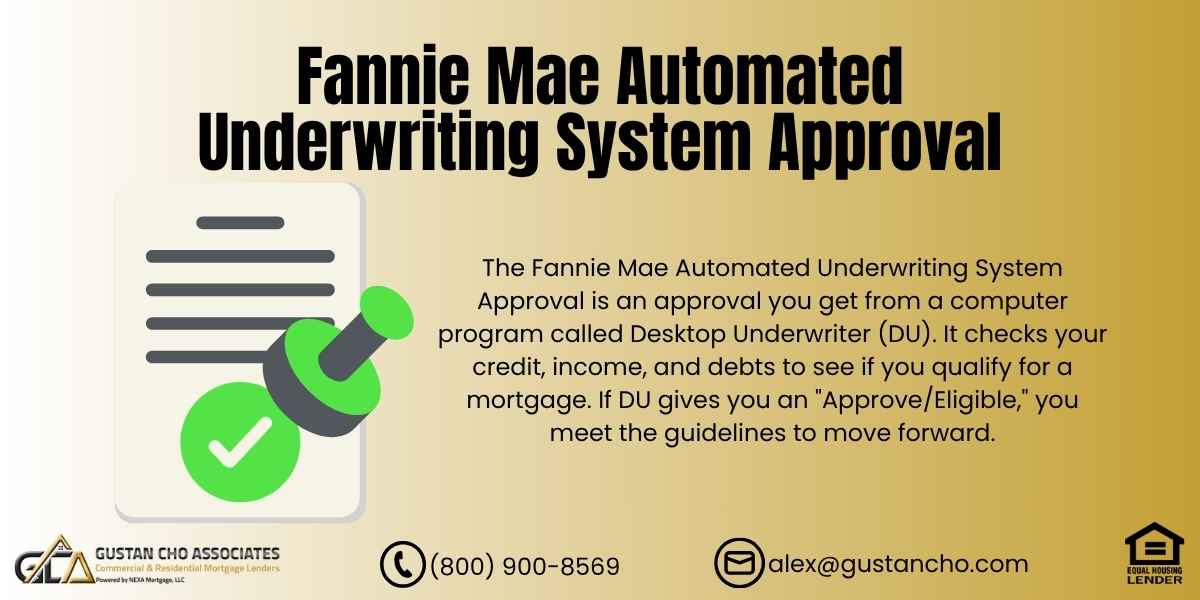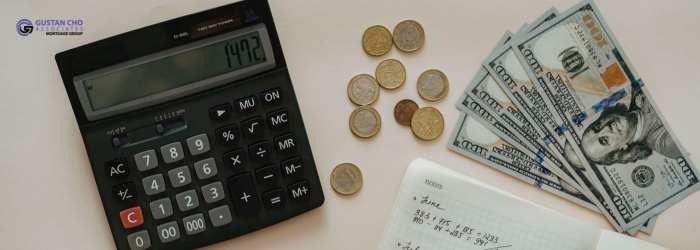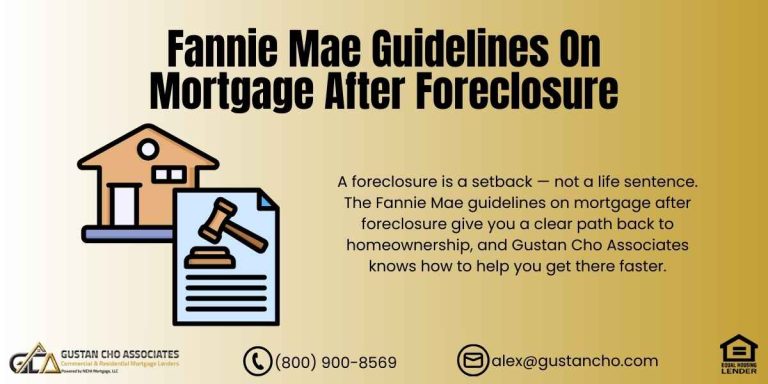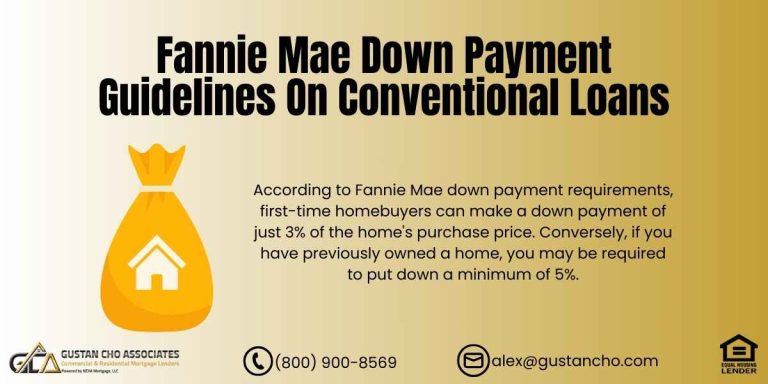Getting a mortgage in 2025 doesn’t need to be a hassle. One of the quickest ways to lock in your financing is by getting approved through the Fannie Mae Automated Underwriting System—often referred to as DU or Desktop Underwriter.
This guide will cover everything you need to know about the Fannie Mae Automated Underwriting System approval: how it works, what it looks for, credit score requirements, and tips to boost your chances of getting approved.
Whether you’re a first-time homebuyer, refinancing, or overcoming past credit challenges, this guide will help you understand how DU can open the door to homeownership.
What Is the Fannie Mae Automated Underwriting System?
The Fannie Mae Automated Underwriting System is a computerized tool lenders use to quickly decide if you qualify for a mortgage. It is officially called Desktop Underwriter (DU).
Instead of waiting for a human underwriter to review everything at the start, DU checks your:
- Credit score and credit history
- Income and employment
- Debt-to-income (DTI) ratio
- Assets and savings
- Rental and housing history
- Derogatory items like bankruptcies, collections, or foreclosures
After analyzing your file, DU issues one of three results:
- Approve/Eligible – This result indicates that you fully meet Fannie Mae’s guidelines, positioning you favorably for mortgage approval. With this status, you can move forward with the loan process with confidence.
- Refer/Eligible – This finding suggests that while you may qualify for a loan, your application requires manual underwriting due to certain factors. It means that further review by an underwriter is needed to determine your eligibility.
- Refer/Ineligible – Receiving this result means that your application does not meet the current Fannie Mae guidelines. You may need to address specific issues to improve your chances of approval in the future.
When DU issues an Approve/Eligible finding, you’re well on your way to mortgage approval.
Fannie Mae AUS Approval: Get Approved Faster and Easier
Simplify your mortgage approval with Fannie Mae’s Automated Underwriting System.
Why Is Fannie Mae Automated Underwriting System Approval Important in 2025?
In 2025, the significance of Fannie Mae Automated Underwriting System approval is greater than ever as mortgage guidelines evolve. The Desktop Underwriter (DU) is now equipped with advanced capabilities, allowing it to process digital bank statements, tax transcripts, and third-party verifications in mere seconds.
This efficiency not only streamlines the underwriting process but also enhances the overall reliability of the approval, giving lenders the confidence they need as DU adheres strictly to Fannie Mae’s official rules, eliminating any guesswork.
At Gustan Cho Associates, we fully trust the findings of DU, operating with a commitment to transparency and efficiency. Unlike many banks that impose additional rules—known as lender overlays—leading to unnecessary denials for borrowers, we believe in a straightforward approach. If DU gives the green light, we also say yes, resulting in quicker closings and fewer client delays. This dedication to leveraging the power of DU ensures a smoother mortgage experience for everyone involved.
How the Fannie Mae Automated Underwriting System Works
Here’s a simple breakdown of how DU works behind the scenes:
- The loan officer enters your info into the system (income, credit, debts, job history).
- DU reviews everything instantly using Fannie Mae’s guidelines.
- DU issues a decision: Approve/Eligible, Refer/Eligible, or Refer/Ineligible.
- If approved, your lender verifies the documents DU requested (pay stubs, W-2s, tax returns).
- Final underwriting signs off, and you’re ready to close.
Think of DU as your first green light in the mortgage process.
What Credit Score Do You Need for DU Approval?
The good news: you don’t need perfect credit.
Conventional Loans
With the Fannie Mae Automated Underwriting System, you can get a conventional loan even if your credit score is as low as 620, making buying a home easier for folks with not-so-great credit. These loans usually come with nice interest rates, but if you put down less than 20%, you’ll need private mortgage insurance (PMI).
FHA Loans
FHA loans, backed by the Federal Housing Administration, provide opportunities for borrowers with lower credit scores. They are often approved through the Fannie Mae Automated Underwriting System Approval. These loans are well-suited for first-time homebuyers with limited credit history or lower financial reserves.
VA Loans
For eligible veterans and active-duty service members, VA loans offer flexible financing options. The VA does not require a minimum credit score, allowing lenders to consider individual circumstances for approval. This leads to potential benefits like zero down payment and no PMI.
USDA Loans
USDA loans are a great way to help people buy homes in rural areas. They use the Fannie Mae Automated Underwriting System to check if you’re eligible based on your credit and the property itself. The best part? They offer 100% financing for those who qualify, making it a really appealing option for anyone looking to buy a home in these designated rural spots.
Tip: Many lenders require higher scores because of overlays. At Gustan Cho Associates, if DU says you’re eligible, we honor it—there are no extra rules.
Understanding Debt-to-Income Ratio (DTI) in DU
Your debt-to-income ratio (DTI) is a big deal when getting loans. It’s how lenders determine if you can handle your monthly payments and repay what you’ve borrowed. The lower your DTI, the better—it shows you’ve got a good balance between what you owe and what you make, making you a more appealing loan option.
Front-end DTI: Mortgage + taxes + insurance + HOA only.
- This ratio focuses on your housing-related expenses, giving lenders insight into the portion of your income that goes toward homeownership costs.
Back-end DTI: All monthly debts, including credit cards, car loans, student loans, and housing payments.
- This approach considers all your debts, giving you a better sense of your total financial situation and how well you can handle taking on more loans.
Quick and Easy Fannie Mae AUS Approval for Your Mortgage
Fannie Mae’s Automated Underwriting System can speed up your loan approval—find out how.
DU DTI Limits in 2025
- FHA loans: Up to 46.9% front-end / 56.9% back-end.
- Conventional loans: Generally up to 50%, but DU may allow more with strong credit or reserves.
- VA loans: No official DTI limit; DU findings determine approval.
A higher DTI doesn’t automatically mean denial. DU considers your entire profile—credit, job stability, savings, and reserves.
Can You Get DU Approval with Bad Credit or Collections?
Yes, it is possible to obtain DU approval even if you have bad credit or collections on your record. One of the key benefits of the Fannie Mae Automated Underwriting System is that it evaluates your entire credit profile rather than solely focusing on prior mistakes. This broader assessment allows for a more holistic view of your financial situation.
The DU system prioritizes several factors, including your recent payment history, current credit score trends, and overall job and income stability.
As a result, even with old collections or a history of late payments, you may still receive an Approve/Eligible finding. This approach opens the door for individuals who have faced credit challenges in the past but are now on a better financial path.
Example Case Study:
A borrower with a 580 score and $2,000 in unpaid collections applied for an FHA loan. DU approved the file because their income was stable, and they had made 12 months of on-time payments on current accounts.
Step-by-Step: How to Get a Fannie Mae AUS Approval Fast
Follow these borrower-friendly steps to improve your chances:
- Gather Documents Early: W-2s, 1099s, pay stubs, tax returns, bank statements, and ID.
- Check Your Credit Report: Fix errors, pay down small balances, and avoid new debt.
- Avoid New Loans: Never open new credit cards or car loans before applying.
- Work With a No-Overlay Lender: Many banks deny loans that DU would approve. At Gustan Cho Associates, DU findings rule.
- Show Consistency: Steady job history, stable housing, and some savings all strengthen your DU case.
What Happens After DU Approval?
When DU issues an Approve/Eligible finding, your loan officer will:
- Collect documents to verify DU inputs.
- Order an appraisal (if required).
- Review any DU-listed conditions (like rental history or reserves).
- Send your file for final underwriting.
Most DU-approved loans close faster because the heavy lifting is already done.
Can DU Deny You with Good Credit?
Even with excellent credit, a Desktop Underwriter (DU) can still deny your loan application. One primary reason for this could be that your income doesn’t adequately cover your existing debt load. Additionally, having no assets or reserves can also lead to a denial. If you’ve just started a job and lack a track record in your field, this may further jeopardize your chances of approval.
It’s important to remember that balance is a big deal when getting approved. DU looks at your overall financial situation instead of just zeroing in on your credit score.
For example, even if you’ve got a credit score of 740, that doesn’t guarantee you’ll get the green light if your debt-to-income ratio is too high or your income is a bit shaky. So, having a solid financial picture is super important for getting that approval.
Manual Underwriting vs. DU Approval
Getting a Refer/Eligible from Desktop Underwriter (DU) doesn’t mean you’re out of luck; you could still get approved through manual underwriting. This indicates that a human will thoroughly review your complete application. Although it is feasible to obtain approval this way, it may be more challenging, particularly if you have encountered some recent credit problems. Plus, the manual process usually takes longer. It might require extra backup, like a bigger down payment, cash reserves, or even a co-borrower who doesn’t live with you.
It’s best to apply through the Fannie Mae Automated Underwriting System approval if you can. This route is usually quicker and easier than manual underwriting, needing fewer exceptions, which makes the whole approval process smoother. Automated approval can help streamline your mortgage experience and get things moving faster.
Final Tips to Win DU Approval in 2025
- Stay on your job for at least 2 years if possible.
- Save up for closing costs and a few months of reserves.
- Keep all accounts current—no late payments in the last 12 months.
- Use down payment assistance or gift funds if needed (DU allows it).
Remember: you don’t need perfect credit to win DU approval—you need a balanced profile and the right lender.
Fannie Mae AUS: Fast Mortgage Approval with Minimal Hassle
See how the AUS process can make your mortgage application smoother and faster.
Work With Experts Who Trust Fannie Mae Automated Underwriting System Approval
At Gustan Cho Associates, we help borrowers nationwide get approved every day—even after being denied elsewhere.
- We trust DU findings.
- No overlays, no hidden rules.
- Licensed in 50 states, including DC, Puerto Rico, and the U.S. Virgin Islands.
Borrowers who need a five-star national mortgage company who are experts on Fannie Mae Automated Underwriting System approval, please contact us at 800-900-8569, text us for a faster response, or email us at alex@gustancho.com.
If DU says yes, we say yes.
Final Word: Unlock Your Mortgage with Fannie Mae AUS Approval
The Fannie Mae Automated Underwriting System approval is the key to fast, stress-free mortgage approval in 2025. If you’ve been denied elsewhere or feel overwhelmed, remember: DU findings are powerful, and with the right lender, you can close on your dream home.
Don’t wait. Apply Now for Fannie Mae Automated Underwriting System Approval and see how easy the process can be with Gustan Cho Associates.
Frequently Asked Questions About Fannie Mae Automated Underwriting System Approval:
Q: What is the Fannie Mae Automated Underwriting System Approval?
A: It’s an approval you get from a computer program called Desktop Underwriter (DU). It checks your credit, income, and debts to see if you qualify for a mortgage. If DU gives you an “Approve/Eligible,” you meet the guidelines to move forward.
Q: How do I Get a Fannie Mae Automated Underwriting System Approval?
A: You apply with a lender like Gustan Cho Associates. We enter your information—such as your income, credit score, and debts—into the system and run it through DU. If DU gives you an “Approve/Eligible,” you’re on your way to getting approved.
Q: What Credit Score do I Need for a Fannie Mae Automated Underwriting System Approval?
A: You may qualify for a conventional loan with a score as low as 620. If you’re going FHA, it can be even lower. Gustan Cho Associates doesn’t have extra rules, so we go with what DU says.
Q: Can I Get a Fannie Mae Automated Underwriting System Approval with Bad Credit?
A: Yes. DU looks at more than just your score. If your recent payment history is solid and your job and income are steady, you can still get approved, even with old collections or late payments.
Q: Does DU Consider All My Debts When Giving a Fannie Mae Automated Underwriting System Approval?
A: Yes. DU checks your debt-to-income ratio (DTI), which includes your mortgage, car loans, credit cards, and more. If your income is strong enough to handle your monthly payments, you have a good shot at approval.
Q: What Happens After Receiving a Fannie Mae Automated Underwriting System Approval?
A: Once you get an “Approve/Eligible” response from DU, your lender will request documents such as pay stubs, W-2 forms, and bank statements. After that, they will submit your loan for underwriting to obtain the final approval.
Q: Can I Get Denied After a Fannie Mae Automated Underwriting System Approval?
A: You should be fine if you gave the correct info and your documents match what DU approved. But if something major changes—like losing your job or taking on new debt—it could affect the final decision.
Q: What if I Don’t Get a Fannie Mae Automated Underwriting System Approval?
A: If DU gives you a “Refer/Eligible,” you might still qualify with manual underwriting. That means a real person looks at your file instead of a computer. It takes longer, but it’s still possible to get approved.
Q: Can the Fannie Mae Automated Underwriting System Approval Work for FHA or VA Loans?
A: Yes! Even though DU is from Fannie Mae, lenders also use it to approve FHA, VA, and USDA loans. Gustan Cho Associates uses DU for all loan types with no overlays.
Q: Why Should I Work with Gustan Cho Associates for Fannie Mae Automated Underwriting System Approval?
A: We don’t add extra rules to DU’s decision. If DU says you’re approved, we move forward—no games, no delays. We’re open 7 days a week to help you get approved fast.
This blog about “Fannie Mae Automated Underwriting System Approval” was updated on September 4th, 2025.
Want to Know How Fannie Mae AUS Approval Works?
We’ll guide you through the AUS process and help you secure a faster mortgage approval.










